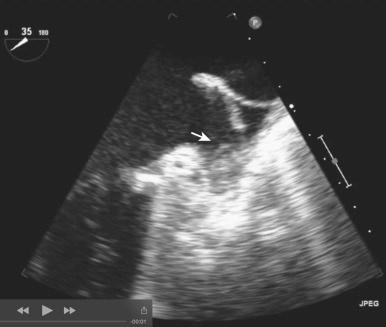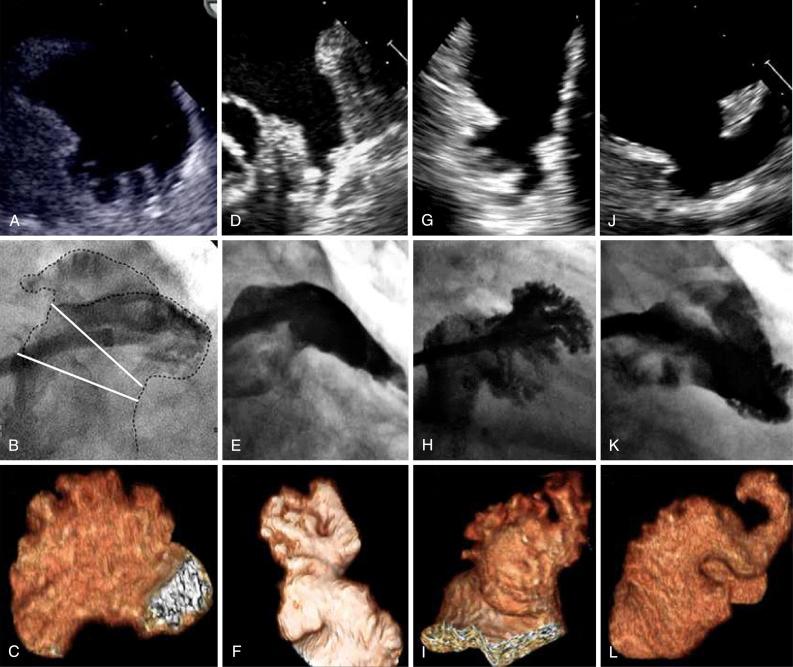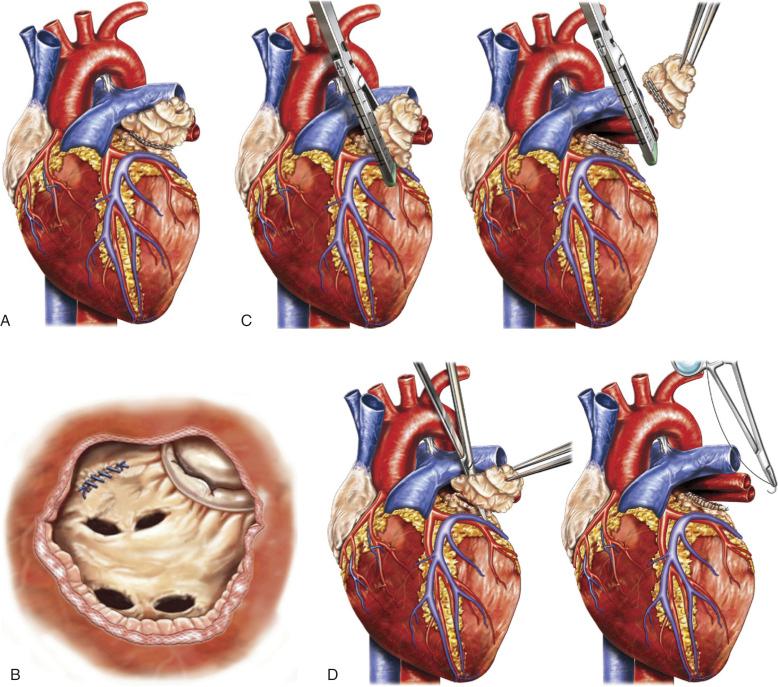Physical Address
304 North Cardinal St.
Dorchester Center, MA 02124
Atrial fibrillation (AF) is associated with substantial morbidity and mortality due to stroke and systemic embolism.
The left atrial appendage (LAA) appears to be the primary source of thromboembolism in AF and therefore is a target for mechanical therapies for stroke reduction.
Although concomitant LAA excision or exclusion is commonly performed during cardiac surgery in high-risk patients, insufficient resection or postoperative residual leaks occur frequently and may be associated with thrombus and embolic events.
Observational studies have provided conflicting results regarding the efficacy of surgical LAA closure for stroke reduction.
Two randomized clinical trials that compared the Watchman LAA occluder with warfarin in oral anticoagulation–eligible patients have shown that closure with the device is an acceptable alternative to long-term warfarin in some patients for the prevention of cardiovascular death, stroke, and systemic embolism.
The Amplatzer Cardiac Plug and the second-generation Amulet occlude the LAA using a mechanism different from that of the Watchman. Several small-scale, observational case series suggest that outcomes for the Amplatzer devices are similar to those for the Watchman device.
Evaluation of the patient with AF incorporates an assessment of thromboembolic and bleeding risk using well-validated risk schemes, such as the CHA 2 DS 2 -VASc and HAS-BLED scores, which are based on individual comorbidity profiles.
Appropriate patient selection for transcatheter LAA closure requires the assessment of the individual’s risk of thromboembolism, long-term bleeding risk on oral anticoagulation, short-term procedural risk of device implantation, medication noncompliance, and patient preference.
Atrial fibrillation (AF) is associated with a significant risk of stroke and systemic embolism. The worldwide prevalence of this arrhythmia is increasing substantially as the global population ages. Although long-term treatment with oral anticoagulation (OAC) reduces thromboembolic risk, it is associated with an ongoing bleeding hazard and other limitations that deter its use.
The left atrial appendage (LAA) appears to be the dominant source of thromboembolism in patients with AF and has been described as “our most lethal human attachment.” LAA contraction during sinus rhythm leads to vigorous blood flow in and out the appendage cavity, but LAA contractile dysfunction during AF can predispose to local stasis, thrombosis, and systemic embolization. Local therapies that exclude the LAA from the systemic circulation offer a mechanical alternative to OAC for cardioembolic stroke protection in these patients, and several devices for transcatheter LAA closure have been developed.
This chapter summarizes the approaches to risk assessment for AF patients, describes the mechanistic basis for LAA closure, reviews the devices with the Conformité Européenne (CE) mark or U.S. Food and Drug Administration (FDA) clearance and their safety and efficacy data sets, and provides a framework for selecting the appropriate patient for device therapy.
AF is the most common arrhythmia in the United States and is associated with significant morbidity and mortality. AF results in up to a fivefold increased risk of stroke, a twofold increased risk of dementia, a threefold increased risk of heart failure, and a 40% to 90% increased risk of overall mortality. The overall global burden of AF, its incidence, its prevalence, and its associated mortality have progressively increased over the past two decades, and the prevalence of AF in the United States is expected to rise to between 5.6 and 12 million cases in 2050.
Risk factors for AF include advancing age, male sex, diabetes mellitus, obesity, hypertension, and European ancestry. The cumulative risk of AF by 80 years of age in the Atherosclerosis Risk in Communities (ARIC) study was 21% among white men, 17% among white women, and 11% among African Americans.
In addition to symptoms such as fatigue, palpitations, and shortness of breath, AF is associated with substantial morbidity, primarily due to stroke and thromboembolism. Paroxysmal, persistent, or permanent forms of AF increase stroke risk to a similar degree. Subclinical AF of more than 6 minutes’ duration has been associated with an increased risk of ischemic stroke or systemic embolism.
The relative contribution of AF to stroke is particularly large among the elderly. AF accounted for approximately 24% of strokes in those 80 to 89 years of age in the Framingham Heart Study. AF-related ischemic strokes are more likely to be fatal than non-AF strokes, and among survivors, AF-related strokes are greater in severity and recur more frequently.
An individualized assessment of thromboembolic risk is a critical part of the therapeutic decision-making process. The CHADS 2 and CHA 2 DS 2 VASc scores are well-validated schemes for the risk stratification of ischemic stroke and systemic thromboembolism. Based on the individual comorbidities defined in Table 50.1 , the scores are used to estimate the yearly risk of thromboembolic events and identify patients with AF who may derive clinical benefit from OAC ( Table 50.2 ). The CHA 2 DS 2 VASc score refines the CHADS 2 score by providing greater weight for elderly age (A 2 ) and incorporating the sex category (Sc) and vascular disease (VA). The CHA 2 DS 2 VASc score can better identify patients who are at low risk (i.e., CHA 2 DS 2 VASc score = 0) and those who may not require OAC. The CHA 2 DS 2 VASc score can also identify those at risk for stroke despite anticoagulation.
| Characteristic | Points |
|---|---|
| CHADS 2 | |
|
1 |
|
1 |
|
1 |
|
1 |
|
2 |
|
6 |
| CHA 2 DS 2 VASc | |
|
1 |
|
1 |
|
2 |
|
1 |
|
2 |
|
1 |
|
1 |
|
1 |
|
9 |
| Score | Adjusted Yearly Stroke Rate (%) |
|---|---|
| CHADS 2 | |
| 0 | 1.9 |
| 1 | 2.8 |
| 2 | 4.0 |
| 3 | 5.9 |
| 4 | 8.5 |
| 5 | 12.5 |
| 6 | 18.2 |
| CHA 2 DS 2 VASc | |
| 0 | 0 |
| 1 | 1.3 |
| 2 | 2.2 |
| 3 | 3.2 |
| 4 | 4.0 |
| 5 | 6.7 |
| 6 | 9.8 |
| 7 | 9.6 |
| 8 | 6.7 |
| 9 | 15.2 |
The 2014 American Heart Association (AHA), American College of Cardiology (ACC), and Heart Rhythm Society (HRS) guidelines for the management of patients with AF recommend calculation of the CHA 2 DS 2 VASc score to assess stroke risk (class I, level B evidence) and the use of oral anticoagulants in patients with a CHA 2 DS 2 VASc score of 2 or greater (class I, level A evidence). The European Society of Cardiology (ESC) guidelines also recommend OAC in patients with a CHA 2 DS 2 VASc score of 2 or greater (class I, level A evidence) and state that OAC should be considered in patients with a CHA 2 DS 2 VASc score of 1 (class IIa, level A evidence).
The decision to treat a particular patient with OAC is often influenced by a real or perceived risk of bleeding. Several bleeding risk stratification schemes have been proposed. The HAS-BLED score, as defined in Table 50.3 , provides better predictive capacity for bleeding events in OAC-treated patients compared with other scores and highlights risk factors that can be actively managed to reduce the bleeding risk. The 2016 update of the ESC guidelines for the management of AF recommend that the HAS-BLED score should be used to assess bleeding risk. In that system, a score of 3 or higher indicates high risk, and some caution and regular review is needed after the initiation of antithrombotic therapy (class IIa, level A evidence). The guidelines further recommend that the HAS-BLED score be used to identify modifiable bleeding risks that need to be addressed, but they do not recommend that it be used on its own to exclude patients from OAC therapy (class IIa, level B evidence).
| Characteristic | Points |
|---|---|
|
1 |
|
|
|
1 |
|
1 |
|
1 |
|
1 |
|
|
|
9 |
a Abnormal liver function was defined as cirrhosis or biochemical evidence of significant hepatic derangement; abnormal renal function was defined as serum creatinine >200 μmol/L (2.26 mg/dL).
The 2014 AHA/ACC/HRS guidelines make no formal recommendations regarding bleeding risk scores. However, it observes that a HAS-BLED score of 3 or higher indicates a high risk of bleeding that requires closer observation of a patient for adverse events, closer monitoring of international normalized ratios (INRs), and differential dose selections of oral anticoagulants or aspirin.
Oral anticoagulants reduce the risk of thromboembolism in patients with nonvalvular AF. Warfarin, a vitamin K antagonist, reduces the risk of ischemic stroke by approximately two-thirds. Successful therapy with warfarin, however, is challenging. Warfarin has a narrow therapeutic window. The pharmacokinetics and pharmacodynamics of warfarin vary considerably because they are influenced by genetics, diet, and numerous drug-drug interactions. Regular laboratory monitoring and dose adjustment are required, and maintenance of anticoagulation in the therapeutic range can be difficult. Patients enrolled in clinical trials were in the therapeutic range 55% to 65% of the time.
The nonvitamin K antagonist oral anticoagulants (NOACs) are noninferior or superior to warfarin for the prevention of stroke and systemic embolism, and they are more convenient because they do not require ongoing monitoring. The efficacy of the NOACs compared with warfarin is driven primarily by reductions in hemorrhagic stroke; rates of ischemic strokes are similar or only modestly reduced. The NOACs are associated with a similar or lower rate of major hemorrhage than warfarin, with the exception of gastrointestinal bleeding, which is greater with all NOACs except apixaban, for which the risk of gastrointestinal bleeding is similar ( Table 50.3 ).
Oral anticoagulants are underused despite their proven efficacy in reducing stroke and systemic embolism. In the 2009 U.S. National Health and Wellness Survey, 36% of AF patients at high risk for thromboembolism were not being treated with an oral anticoagulant. In a large study of commercially insured patients with AF, 47% were not receiving an oral anticoagulant despite being at moderate to high risk for stroke. OAC prescription prevalence did not exceed 50% among AF patients with CHA 2 DS 2- VASc ≥3 in the more than 429,000 patients enrolled in the ACC/National Cardiovascular Data Registry (NCDR) PINNACLE (Practice Innovation and Clinical Excellence) registry between 2009 and 2012. The prevalence of OAC use in high-risk patients was only modestly improved with the introduction of NOACs in 2014. Indeed, patients with highest risk of stroke tend to be associated with lower rates of OAC prescription.
Patient characteristics associated with lower use of OAC include advancing age, perceived barriers to compliance, dementia, falls, hepatic or renal impairment, drug and alcohol abuse, gastrointestinal bleeding, and intracranial hemorrhage. In the Outcomes Registry for Better Informed Treatment of Atrial Fibrillation (ORBIT) study, patient refusal or preference, fall risk, and frailty were the factors associated with the lowest use of OAC among patients at high risk for stroke.
Therapeutic challenges with the NOACs include cost, lack of widely available antidotes (with the exception of dabigatran), side effects, and the need for long-term compliance. The overall bleeding hazard with the NOACs (see Table 50.4 ) must be evaluated in the context of a therapy that needs to be administered for years. The safety and efficacy of NOACs for patients at higher risk for bleeding has not been defined because patients with prior bleeding events or those thought to be at high risk for bleeding were excluded or not well represented in the pivotal randomized trials.
| Study | Study Drug | Major Bleeding a (% Events/100 pt-yr) | GI Bleeding (% Events/100 pt-yr) | ||||||
|---|---|---|---|---|---|---|---|---|---|
| Interv. | Warf. | HR (95% CI) | P Value | Interv. | Warf. | HR (95% CI) | P Value | ||
| RE-LY | Dabigatran b | 3.11% | 3.36% | 0.93 (0.81–1.07) | .31 | 1.51% | 1.02% | 1.50 (1.19–1.89) | < .001 |
| ARISTOTLE | Apixaban | 2.13% | 3.09% | 0.69 (0.60–0.80) | < .001 | 0.76% | 0.86% | 0.89 (0.70–1.15) | .37 |
| ROCKET-AF | Rivaroxaban | 3.60% | 3.4% | 1.04 (0.90–1.20) | .58 | 3.15% | 2.16% | NR | < .001 |
| ENGAGE-AF | Edoxaban b | 2.75% | 3.43% | 0.80 (0.71–0.91) | < .001 | 1.51% | 1.23% | 1.23 (1.02–1.50) | .03 |
a Definitions of major bleeding: RE-LY , clinically overt bleeding with decrease in hemoglobin of ≥2 g/dL, transfusion of ≥2 U of packed red blood cells (PRBCs), or symptomatic bleeding in a critical area or organ; ARISTOTLE and ENGAGE-AF , clinically overt bleeding with a decrease in hemoglobin of ≥2 g/dL or transfusion of ≥2 U of PRBCs, occurring at a critical site or resulting in death; ROCKET-AF , fatal outcome, involvement of a critical anatomic site, decrease in hemoglobin of ≥2 g/dL, transfusion of ≥2 U of PRBCs, or permanent disability.
b Event rates are listed for dabigatran (150 mg bid) and edoxaban (60 mg daily) dosages.
The LAA is a multilobed, trabeculated, broad-shaped structure with a narrow neck. During AF, there is decreased LAA contractility and function, leading to dilation and remodeling and causing the appendage to function as a static pouch, predisposing patients to blood stagnation and thrombosis ( Fig. 50.1 ). Anatomic characteristics of the LAA, such as neck diameter, depth, extent of trabeculations, and cauliflower-type morphology, have been associated with AF stroke risk ( Fig. 50.2 ).


The LAA was the source of more than 90% of thrombi in cases of stroke in which the thrombus could be identified. These data lend support to the hypothesis that elimination of the LAA may offer a preventive strategy for AF-related stroke.
More than 60 years ago, Madden suggested that surgical resection of the LAA in patients with AF could prevent recurrent arterial emboli, and concomitant exclusion or removal of the LAA during cardiac surgery in high-risk AF patients has become commonplace. The heterogeneity of surgical techniques that are used and the lack of randomized data make it particularly challenging to assess whether this approach is effective in reducing the risk of thromboembolism in the absence of long-term OAC.
The two general approaches to surgical LAA closure are exclusion and excision. Exclusion can be performed with running or mattress sutures, with or without felt pledgets, from the endocardial or epicardial surface or with a stapler ( Fig. 50.3 ). Excision can be performed by stapled excision or removal and oversewing. However, postoperative residual leaks and insufficient resection occur frequently and can be associated with thrombus and neurologic events. Incomplete or insufficient closure is more common with suture or staple exclusion than with excision.

The results of observational studies that have examined the association between surgical LAA closure and stroke reduction are conflicting ( Table 50.5 ). The Left Atrial Appendage Occlusion Study III (LAAOS III) is recruiting participants and will randomly assign approximately 4500 patients with AF undergoing cardiac surgery to concomitant surgical LAA excision or exclusion or to conventional medical therapy ( clinicalTrials.gov identifier NCT01561651). The primary end point is the first occurrence of stroke or systemic arterial embolism over a mean follow-up period of 4 years. The results of this trial (scheduled to be completed in 2020) will help define the efficacy of surgical approaches to stroke prevention.
| Study | Country | No. Studied | Closure Method | Closure Success Rate (%) a | Effect of LAA Closure on Stroke Prevention |
|---|---|---|---|---|---|
| Johnson et al. | United States | 437 | Excision | 100 | Positive |
| Katz et al. | United States | 50 | Endocardial suture | 64 | None |
| Garcia-Fernandez et al. | Spain | 205 | Endocardial suture | 90 | Positive |
| Bando et al. | Japan | 812 | Endocardial suture | Not measured | Negative |
| Blackshear et al. | United States | 15 | Thoracoscopic epicardial purse-string | 93 b | Positive |
| Pennec et al. | France | 30 | Endocardial Excision |
70–80 100 |
Negative Positive |
| Schneider et al. | Germany | 6 | Endocardial suture | 17 | Negative |
| Healey et al. | Canada | 77 | Epicardial suture Stapler |
45 72 |
Positive |
| Kanderian et al. | United States | 137 | Excision Suture exclusion Stapler |
73 (20% stapler) 23 0 |
Positive trend |
| Bakhtiary et al. | Germany | 259 | Clamp and epicardial suture | 100 b | Positive |
Become a Clinical Tree membership for Full access and enjoy Unlimited articles
If you are a member. Log in here